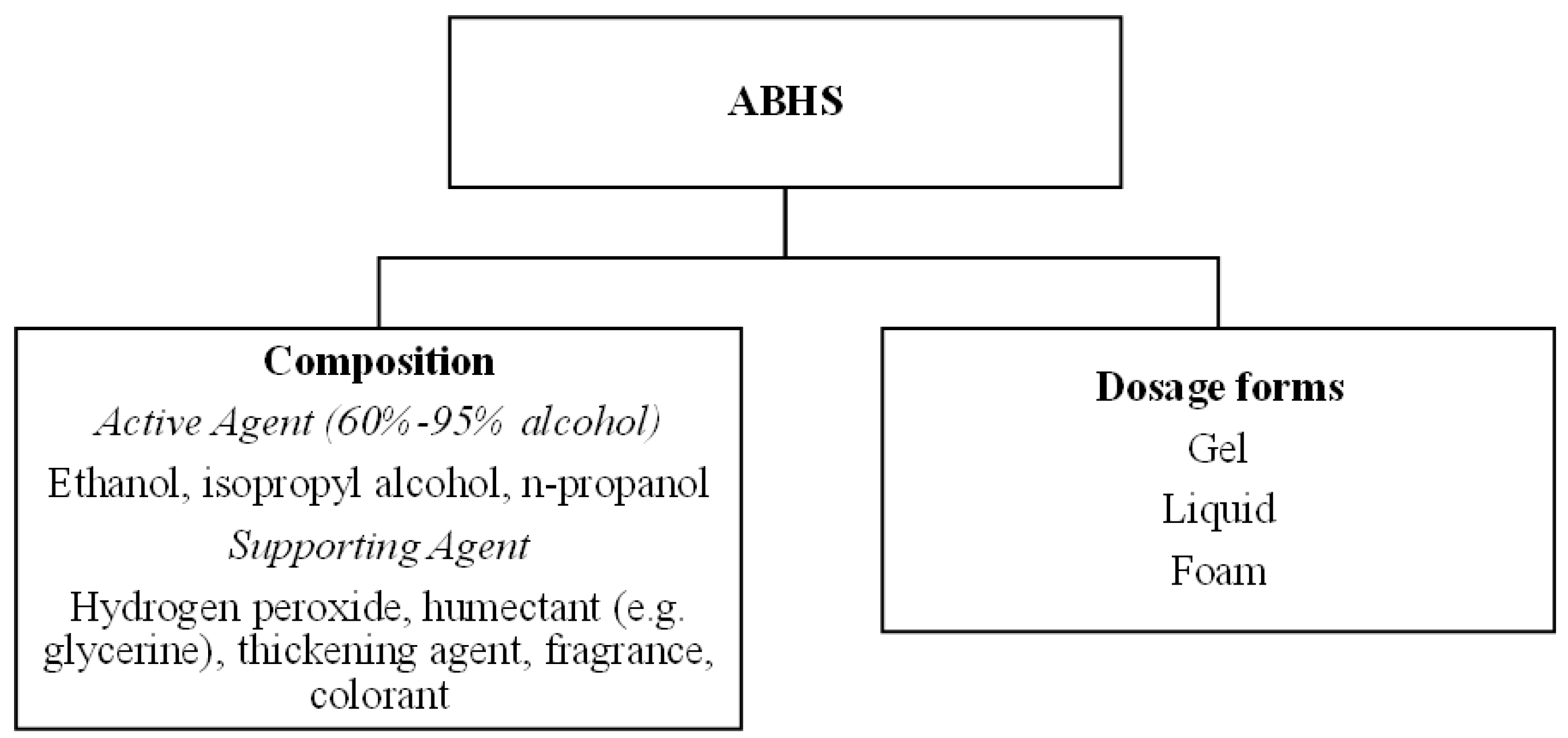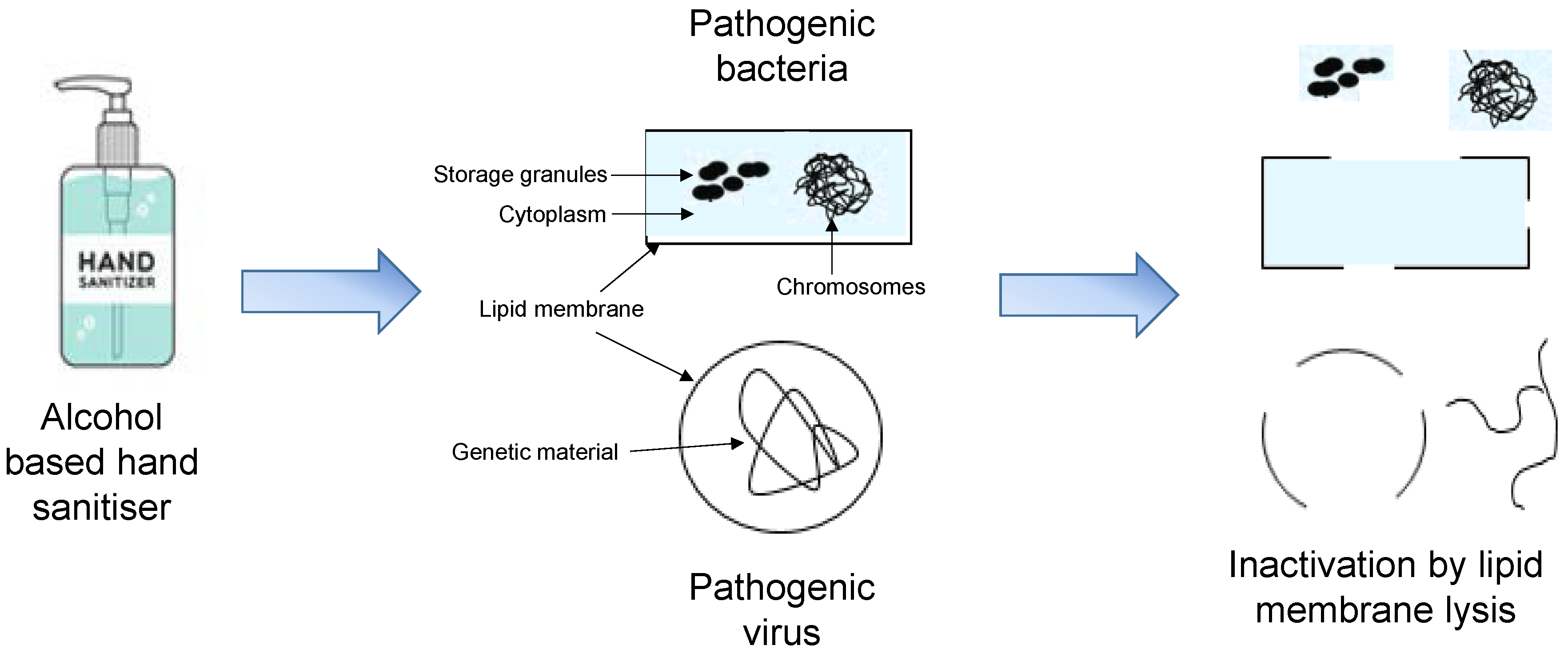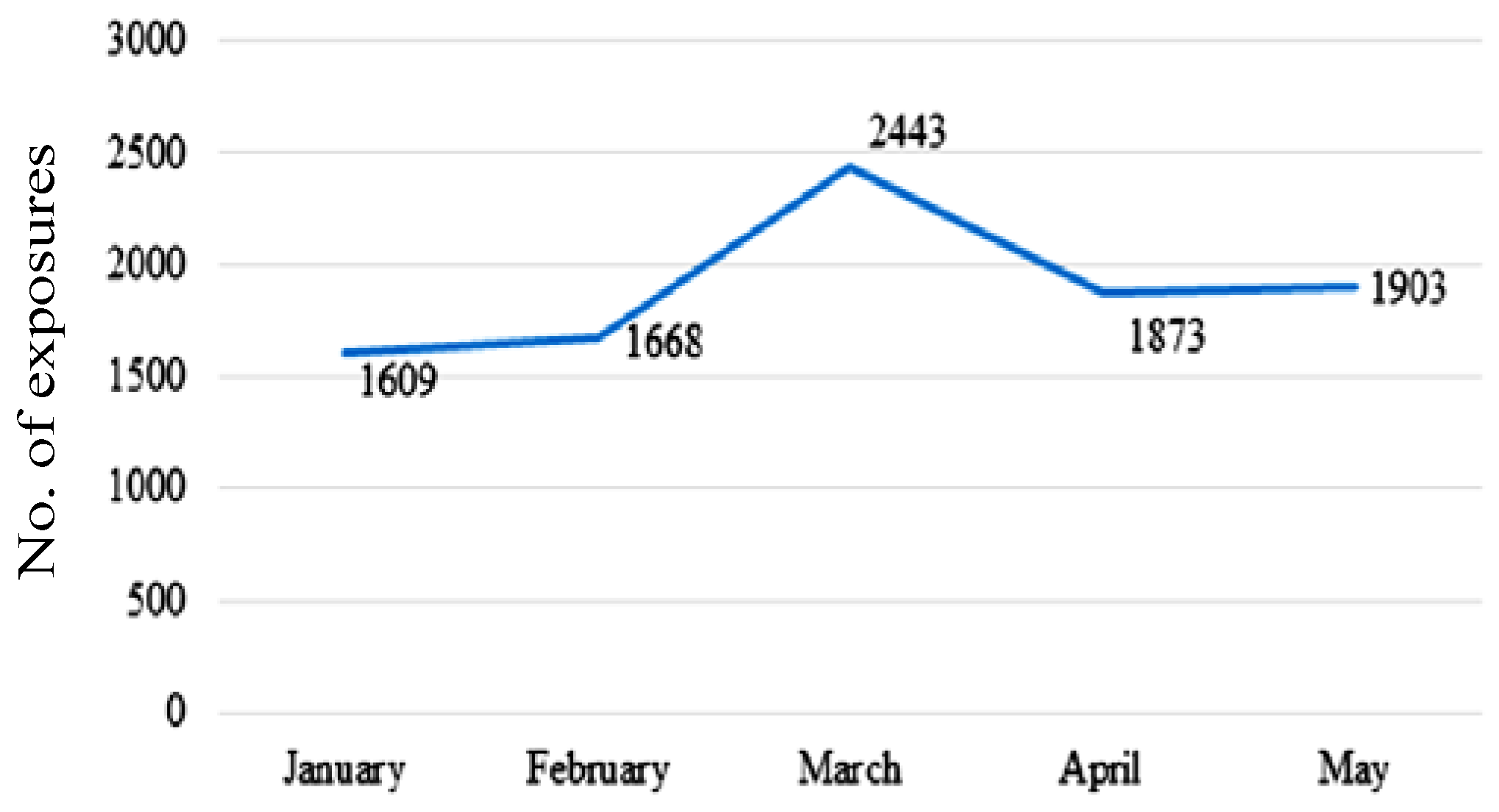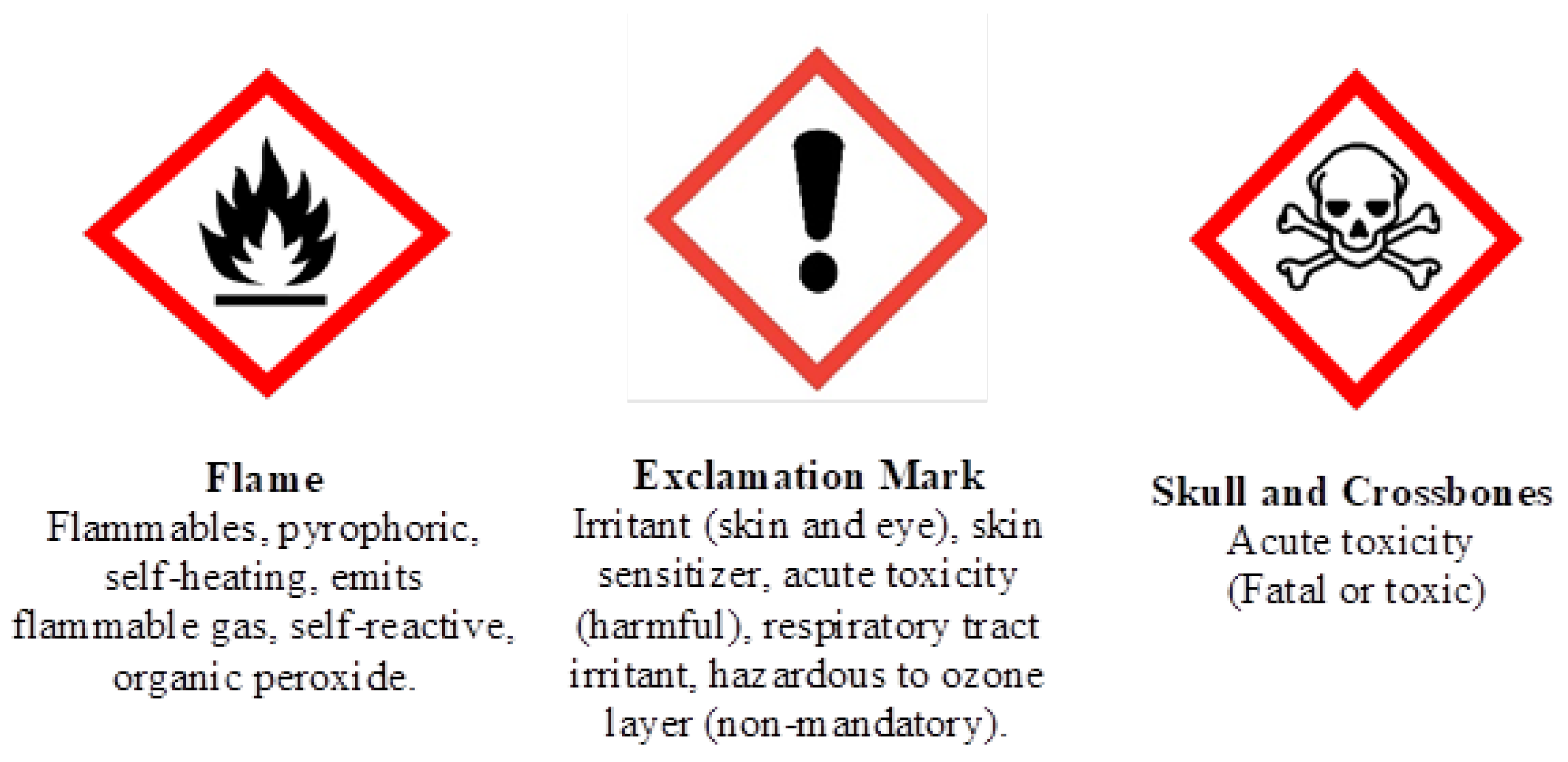Alcohol-Based Hand Sanitizer—Composition, Proper Use and Precautions
Abstract
- Regulatory control on ‘over the counter’ sanitizer products such as ABHS should be a priority to ensure good manufacturing practices are followed and to ensure protection of consumer rights and safety of users.
- Awareness among users is necessary. Purchasing and use of substandard or counterfeit products should be discouraged, while knowledge sharing on appropriate hand hygiene techniques using ABHS should be promoted. Online news media, social media, television, and radio are excellent platforms for the rapid dissemination of information during a pandemic.
- Use of soap and water, rather than ABHS, for hand hygiene and sanitisation is recommended in the case of greasy and visibly dirty hands.
- Before disposing empty ABHS containers into the general waste bins, these should be rinsed with cold water.
- Use of alcoholic beverages as an alternative to ABHS is discouraged because beverages do not contain sufficient concentration of alcohol to achieve effective killing of microorganisms. Instead, such practice can result in hazards and adverse effects such as skin diseases.
Conclusions
Author Contributions
Funding
Conflicts of interest
References
- Marzoli, F.; Bortolami, A.; Pezzuto, A.; et al. A systematic review of human coronaviruses survival on environmental surfaces. Sci Total Environ. 2021, 778, 146191. [Google Scholar] [CrossRef]
- Alzyood, M.; Jackson, D.; Aveyard, H.; Brooke, J. COVID-19 reinforces the importance of handwashing. J Clin Nurs. 2020, 29, 2760–2761. [Google Scholar] [CrossRef]
- Manigandan, S.; Wu, M.T.; Ponnusamy, V.K.; Raghavendra, V.B.; Pugazhendhi, A.; Brindhadevi, K. A systematic review on recent trends in transmission, diagnosis, prevention and imaging features of COVID-19. Process Biochem. 2020, 98, 233–240. [Google Scholar] [CrossRef]
- Tarka, P.; Gutkowska, K.; Nitsch-Osuch, A. Assessment of tolerability and acceptability of an alcohol-based hand rub according to a WHO protocol and using apparatus tests. Antimicrob Resist Infect Control. 2019, 8, 191. [Google Scholar] [CrossRef]
- Vandamme, T.F. Use of rodents as models of human diseases. J Pharm Bioallied Sci. 2014, 6, 2–9. [Google Scholar] [CrossRef] [PubMed]
- Kampf, G.; Todt, D.; Pfaender, S.; Steinmann, E. Persistence of coronaviruses on inanimate surfaces and their inactivation with biocidal agents. J Hosp Infect. 2020, 104, 246–251. [Google Scholar] [CrossRef] [PubMed]
- Güner, R.; Hasanoğlu, I.; Aktaş, F. COVID-19: Prevention and control measures in community. Turk J Med Sci. 2020, 50, 571–577. [Google Scholar] [CrossRef]
- Jing, J.L.J.; Pei Yi, T.; Bose, R.J.C.; McCarthy, J.R.; Tharmalingam, N.; Madheswaran, T. Hand sanitizers: A review on formulation aspects, adverse effects, and regulations. Int J Environ Res Public Health. 2020, 17, 3326. [Google Scholar] [CrossRef] [PubMed]
- Abuga, K.; Nyamweya, N. Alcohol-based hand sanitizers in COVID-19 prevention: A multidimensional perspective. Pharmacy (Basel). 2021, 9, 64. [Google Scholar] [CrossRef]
- Berardi, A.; Perinelli, D.R.; Merchant, H.A.; et al. Hand sanitizers amid COVID-19: A critical review of alcohol- based products on the market and formulation approaches to respond to increasing demand. Int J Pharm. 2020, 584, 119431. [Google Scholar] [CrossRef]
- Davies, K.; Buczkowski, H.; Welch, S.R.; et al. Effective in vitro inactivation of SARS-CoV-2 by commercially available mouthwashes. J Gen Virol. 2021, 102, 001578. [Google Scholar] [CrossRef]
- Assis, M.S.; Araújo, R.A.A.M.; Lopes, A.M.M. Safety alert for hospital environments and health professional: Chlorhexidine is ineffective for coronavirus. Rev Assoc Med Bras (1992). 2020, 66 (Suppl. S2), 124–129. [Google Scholar] [CrossRef]
- Bidra, A.S.; Pelletier, J.S.; Westover, J.B.; Frank, S.; Brown, S.M.; Tessema, B. Comparison of in vitro inactivation of SARS CoV-2 with hydrogen peroxide and povidone-iodine oral antiseptic rinses. J Prosthodont. 2020, 29, 599–603. [Google Scholar] [CrossRef] [PubMed]
- Kratzel A, Todt D, V’kovski; et al. Inactivation of severe acute respiratory syndrome coronavirus 2 by WHO-recommended hand rub formulations and alcohols. Emerg Infect Dis. 2020, 26, 1592–1595. [Google Scholar] [CrossRef]
- Kenters, N.; Eikelenboom-Boskamp, A.; Hines, J.; McGeer, A.; Huijskens, E.G.W.; Voss, A. Product dose considerations for real-world hand sanitizer efficacy. Am J Infect Control. 2020, 48, 503–506. [Google Scholar] [CrossRef] [PubMed]
- Miron, V.D. Drugs in COVID-19 – life-saving or potentially hazardous approaches. J Contemp Clin Pract. 2020, 6, 47. [Google Scholar] [CrossRef]
- Gharpure, R.; Hunter, C.M.; Schnall, A.H.; et al. Knowledge and practices regarding safe household cleaning and disinfection for COVID-19 prevention - United States, May 2020. MMWR Morb Mortal Wkly Rep. 2020, 69, 705–709. [Google Scholar] [CrossRef]
- World Health Organization. Guide to local production: WHO-recommended handrub formulations. 2010. Available online: https://www.who.int/gpsc/5may/Guide_to_Local_Prod uction.pdf (accessed on 11 June 2021).
- Morton, H.E. The relationship of concentration and germicidal efficiency of ethyl alcohol. Ann N Y Acad Sci. 1950, 53, 191–196. [Google Scholar] [CrossRef]
- Ramasethu, J. Prevention and treatment of neonatal nosocomial infections. Matern Health Neonatol Perinatol. 2017, 3, 5. [Google Scholar] [CrossRef]
- Di Muzio, M.; Cammilletti, V.; Petrelli, E.; Di Simone, E. Hand hygiene in preventing nosocomial infections:a nursing research. Annali Di Igiene: Medicina Preventiva E Di Comunita 2015, 27, 485–491. [Google Scholar]
- Malherbe, H.; Nugier, A.; Clément, J.; Lamboy, B. [Evidence- based and promising interventions to prevent infectious diseases among youth as a result of poor hand hygiene in schools: A literature review]. Sante Publique. 2013, 25 (Suppl. 1), 57–63. [Google Scholar] [CrossRef]
- Kampf, G. Efficacy of ethanol against viruses in hand disinfection. J Hosp Infect. 2018, 98, 331–338. [Google Scholar] [CrossRef]
- Leslie, R.A.; Zhou, S.S.; Macinga, D.R. Inactivation of SARS- CoV-2 by commercially available alcohol-based hand sanitizers. Am J Infect Control. 2021, 49, 401–402. [Google Scholar] [CrossRef]
- Ellis-Caleo, T.; Burstein, S. A case of hand sanitizer intoxication. In Proceedings of UCLA Healthcare; 2017. [Google Scholar]
- Lachenmeier, D.W. Safety evaluation of topical applications of ethanol on the skin and inside the oral cavity. J Occup Med Toxicol. 2008, 3, 26. [Google Scholar] [CrossRef]
- Kirschner, M.H.; Lang, R.A.; Breuer, B.; et al. Transdermal resorption of an ethanol- and 2-propanol-containing skin disinfectant. Langenbecks Arch Surg. 2009, 394, 151–157. [Google Scholar] [CrossRef] [PubMed]
- Kramer, A.; Below, H.; Bieber, N.; et al. Quantity of ethanol absorption after excessive hand disinfection using three commercially available hand rubs is minimal and below toxic levels for humans. BMC Infect Dis. 2007, 7, 117. [Google Scholar] [CrossRef]
- LaHood, A.J.; Kok, S.J. Ethanol Toxicity; StatPearls Publishing: Treasure Island, FL, USA, 2021; Available online: https://www.ncbi.nlm.nih.gov/books/NBK557381/ (accessed on 11 June 2021).
- Wilson, M.E.; Guru, P.K.; Park, J.G. Recurrent lactic acidosis secondary to hand sanitizer ingestion. Indian J Nephrol. 2015, 25, 57–59. [Google Scholar] [CrossRef] [PubMed]
- Mahmood, A.; Eqan, M.; Pervez, S.; et al. COVID-19 and frequent use of hand sanitizers; human health and environmental hazards by exposure pathways. Sci Total Environ. 2020, 742, 140561. [Google Scholar] [CrossRef] [PubMed]
- Altunisik Toplu, S.; Altunisik, N.; Turkmen, D.; Ersoy, Y. Relationship between hand hygiene and cutaneous findings during COVID-19 pandemic. J Cosmet Dermatol. 2020, 19, 2468–2473. [Google Scholar] [CrossRef]
- Moon, J.M.; Chun, B.J.; Min, Y.I. Hemorrhagic gastritis and gas emboli after ingesting 3% hydrogen peroxide. J Emerg Med. 2006, 30, 403–406. [Google Scholar] [CrossRef]
- Sung, J.; Cossarini, F.; Palaiodimos, L.; Benson, B.; Meholli, M. Extra oxygen leads to bubble trouble: Portal vein gas embolism from 3% hydrogen peroxide ingestion. Cureus. 2018, 10, e2136. [Google Scholar] [CrossRef]
- Watt, B.E.; Proudfoot, A.T.; Vale, J.A. Hydrogen peroxide poisoning. Toxicol Rev. 2004, 23, 51–57. [Google Scholar] [CrossRef]
- Ghannoum, M.; Hoffman, R.S.; Mowry, J.B.; Lavergne, V. Trends in toxic alcohol exposures in the United States from 2000 to 2013: A focus on the use of antidotes and extracorporeal treatments. Semin Dial. 2014, 27, 395–401. [Google Scholar] [CrossRef]
- Moon, C.S. Estimations of the lethal and exposure doses for representative methanol symptoms in humans. Ann Occup Environ Med. 2017, 29, 44. [Google Scholar] [CrossRef] [PubMed]
- Choi, J.H.; Lee, S.K.; Gil, Y.E.; et al. Neurological complications resulting from non-oral occupational methanol poisoning. J Korean Med Sci. 2017, 32, 371–376. [Google Scholar] [CrossRef] [PubMed]
- Paasma, R.; Hovda, K.E.; Tikkerberi, A.; Jacobsen, D. Methanol mass poisoning in Estonia: Outbreak in 154 patients. Clin Toxicol (Phila). 2007, 45, 152–157. [Google Scholar] [CrossRef]
- Jairoun, A.A.; Al-Hemyari, S.S.; Shahwan, M. The pandemic of COVID-19 and its implications for the purity and authenticity of alcohol-based hand sanitizers: The health risks associated with falsified sanitizers and recommendations for regulatory and public health bodies. Res Social Adm Pharm. 2021, 17, 2050–2051. [Google Scholar] [CrossRef]
- Chan, A.P.L.; Chan, T.Y.K. Methanol as an unlisted ingredient in supposedly alcohol-based hand rub can pose serious health risk. Int J Environ Res Public Health. 2018, 15, 1440. [Google Scholar] [CrossRef]
- Boelhouwer, E.; Davis, J.; Franco-Watkins, A.; Dorris, N.; Lungu, C. Comprehension of hazard communication: Effects of pictograms on safety data sheets and labels. J Safety Res. 2013, 46, 145–155. [Google Scholar] [CrossRef]
- Montagne, M. Pharmaceutical pictograms: A model for development and testing for comprehension and utility. Res Social Adm Pharm. 2013, 9, 609–620. [Google Scholar] [CrossRef] [PubMed]
- Wilkinson, A. Does hand sanitizer expire? Available online: https://www.singlecare.com/blog/news/does-hand-sanitizer-expire/#:~:text=The%20short%20answer%20is%3A%20Yes%2C%20hand%20sanitizer%20does%20expire.&text=As%20an%20over%2Dthe%2Dcounter,shelf%20lif e%20of%20three%20years (accessed on 11 June 2021).
- US Food and Drug Administration. 2020. Available online: https://www.fda.gov/drugs/information-drug-class/qa- consumers-hand-sanitizers-and-covid-19 (accessed on 11 June 2021).
- Gold, N.A.; Mirza, T.M.; Avva, U. Alcohol Sanitizer; StatPearls Publishing: Treasure Island, FL, USA, 2021; Available online: https://www.ncbi.nlm.nih.gov/books/NBK513254/ (accessed on 11 June 2021).
- Centers for Disease Control and Prevention. 2020. Available online: https://www.cdc.gov/handwashing/hand-sanitizer- use.html (accessed on 11 June 2021).
- New Zealand Government. 2020. Available online: https://covid19.govt.nz/health-and- wellbeing/protect-yourself-and-others/wash-your- hands/#how-to-use-hand-sanitiser (accessed on 11 June 2021).
- Christie, S.; Sidhu, B. The efficacy of alcohol-based hand sanitizers used in a series, modifying the ASTM E2755 method with a shorter hand sanitizer application time. BCIT Environ Public Health J 2014. [CrossRef]
- World Health Organization. WHO guidelines on hand hygiene in health care (advanced draft): A summary. World Health Organization. 2005. Available online: http://apps.who.int/iris/bitstream/handle/10665/6914 3/WHO_EIP_SPO_QPS_05.2.pdf (accessed on 11 June 2021).






 |
© GERMS 2021.
Share and Cite
Saha, T.; Khadka, P.; Das, S.C. Alcohol-Based Hand Sanitizer—Composition, Proper Use and Precautions. Germs 2021, 11, 408-417. https://doi.org/10.18683/germs.2021.1278
Saha T, Khadka P, Das SC. Alcohol-Based Hand Sanitizer—Composition, Proper Use and Precautions. Germs. 2021; 11(3):408-417. https://doi.org/10.18683/germs.2021.1278
Chicago/Turabian StyleSaha, Tushar, Prakash Khadka, and Shyamal C. Das. 2021. "Alcohol-Based Hand Sanitizer—Composition, Proper Use and Precautions" Germs 11, no. 3: 408-417. https://doi.org/10.18683/germs.2021.1278
APA StyleSaha, T., Khadka, P., & Das, S. C. (2021). Alcohol-Based Hand Sanitizer—Composition, Proper Use and Precautions. Germs, 11(3), 408-417. https://doi.org/10.18683/germs.2021.1278



